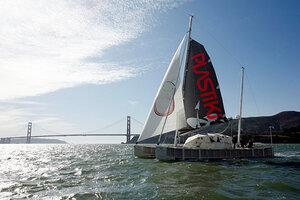Voyage of recycled Plastiki to sail through Pacific garbage patch
The Plastiki, a boat made from recycled plastic, is sailing from San Francisco to Sydney to raise awareness about ocean-borne plastic litter, particularly in the Pacific garbage patch.

The Plastiki, a 60-foot sailing catamaran built by British adventurer David de Rothschild, goes on a test sail in San Francisco Bay on Feb. 11. The vessel, built from more than 11,000 reclaimed bottles and other recycled plastic and waste products, is sailing from San Francisco to Sydney through the Pacific garbage patch.
Robert Galbraith/Reuters
San Francisco
A catamaran with recycled plastic sails and a hull full of reclaimed soda jugs cast off the California coastline last weekend on a social mission to bring attention to the tons of other plastic floating around in the ocean.
The recycled boat, called the Plastiki, and its 11,000 nautical mile journey from San Francisco to Sydney was the brainchild of adventurer and environmentalist David de Rothschild, of the British Rothschild banking family.
Mr. de Rothschild’s high-seas crusade comes as there's growing attention on the world's oceans. Earlier this month, “The Cove,” a documentary on the mass killing of dolphins in Japan, won the Academy Award for best documentary. And in recent weeks, Capt. Charles Moore, who is credited with first bringing attention to the “Great Pacific Garbage Patch,” has been making the rounds on late-night TV to raise awareness about plastic pollutants.
IN PICTURES: Voyage of the Plastiki
“The oceans are getting a lot of attention, but to be honest with you the problem is not getting better at the rate we’d like it to be,” says Elisabeth Guilbaud-Cox, officer in charge of the North America office of the United Nations Environment Program (UNEP), which issued a report on the oceans that inspired de Rothschild’s Plastiki voyage.
The 2006 United Nations Environment Program (UNEP) report, “Ecosystems and Biodiversity in Deep Waters and High Seas,” said that “over 46,000 pieces of plastic litter are floating on every square mile of ocean today.”
“It’s the most dangerous type of litter in the ocean,” says Ms. Guilbaud-Cox, as it’s blamed for killing as many as 1 million sea birds and hundreds of thousands of sea mammals annually.
De Rothschild: a 'climate hero'
De Rothschild, who the UNEP named a “climate hero” last year, certainly has the means and charisma to boost awareness about the problem of plastics in the ocean with this adventure that’s part showmanship, part experiment in social media activism, and part eco-ingenuity,
The Plastiki, which takes its name partially from its plastic origins but also from the 1947 Kon-Tiki expedition, is not only buoyed by about 12,000 two-liter plastic bottles, it’s constructed with recyclable plastic, equipped with solar panels, bicycle-powered generators, and a water recovery system.
It's undoubtedly the greenest high-tech vessel the ocean has seen.
And all along the way, de Rothschild and crew will be twittering and blogging. The boat is equipped with cameras and a National Geographic filmmaker is part of the crew (expect a documentary to follow). Anyone can track the Plastiki’s progress online as it slowly (at about the speed of a jogger) makes its way across the pacific on the three-month expedition.
“What we wanted to do with this project is to create something that was designed to show efficiency ... and to say that these [plastic bottles] can be used again as a resource rather than being thrown out as waste,” de Rothschild recently told CNN.
Plowing through the Pacific garbage patch
He's not against all plastic, mind you, but is taking aim at plastic bottles and bags that are designed to be used and discarded. According to Project Aware, an environmentalist group, only 20 percent of recyclable plastic bottles are actually recycled.
The Plastiki plans to blow through one of the biggest concentrations of the ocean’s plastic waste, the so-called garbage patch that Captain Moore recently called “a disgusting plastic cesspool” on The Colbert Report.
Marieta Francis, executive director of the Algalita Marine Research Foundation, which was founded by Moore in 1994, says she hopeful the attention garnered by the Plastiki might begin changing consumer attitudes about throw-away plastics.
“What one person can do is stop buying those single-use items,” she says. “Plastic is a product that is meant to last forever, and we are creating things out of it that are meant for one-time use.”
